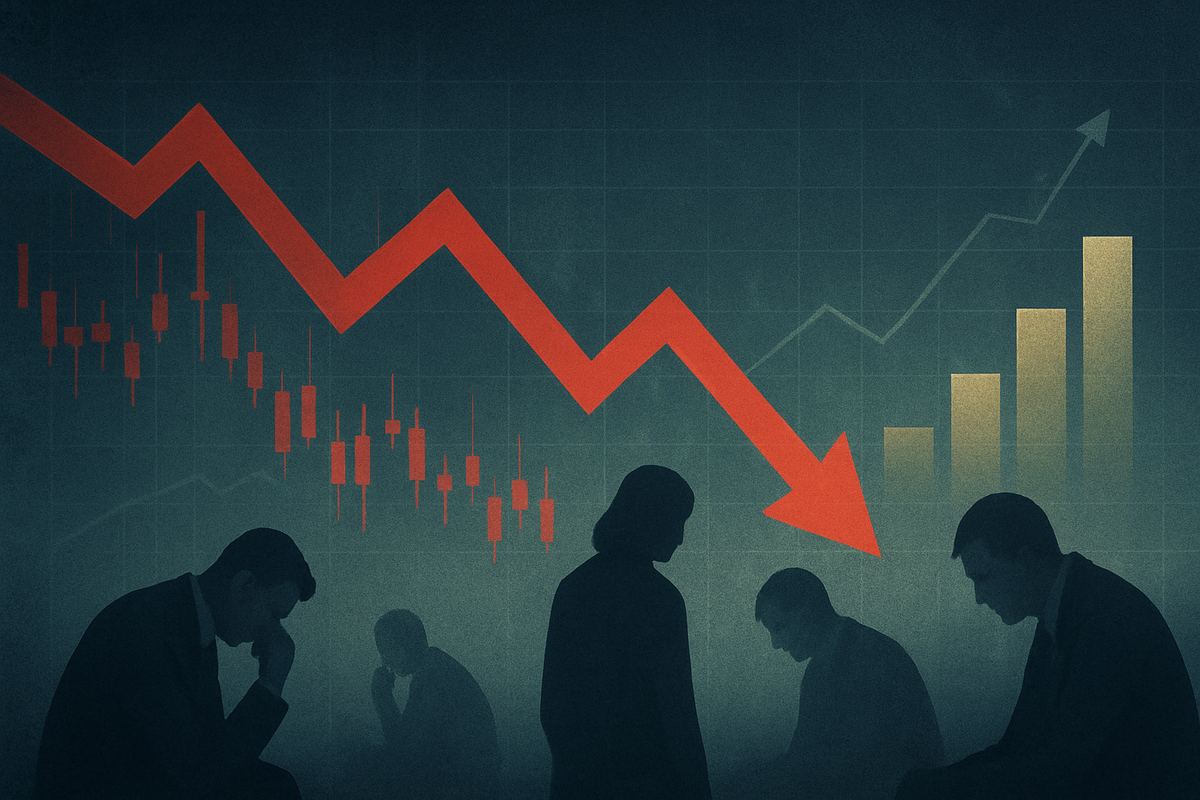
Global financial markets are currently gripped by a palpable "risk-off" sentiment, sending investors scurrying away from speculative assets and towards the perceived safety of traditional havens. This pronounced shift, evident as of November 2025, is contributing to a noticeable downturn across various sectors, signaling a period of heightened caution and re-evaluation. The prevailing mood suggests a collective anxiety among market participants, driven by a complex web of economic uncertainties and geopolitical tremors, prompting a fundamental reassessment of investment strategies and risk exposure.
This retreat from riskier ventures implies that investors are prioritizing capital preservation amidst a turbulent landscape. Major global stock indices have recorded losses, with US small-capitalization indices and the Nasdaq 100 notably underperforming, while European markets also experience declines. The VIX volatility index, often dubbed the "fear gauge," stands elevated, reflecting a moderate, though not panic-level, investor nervousness. This defensive posture is not merely a fleeting reaction but rather a deep-seated recalibration, with profound implications for public companies and the broader economic outlook.
Unpacking the Drivers: A Confluence of Concerns
The current "risk-off" environment is the culmination of several interconnected developments throughout 2025, creating a perfect storm of uncertainty. A hypothetical timeline illustrates how these factors have converged to shape today's cautious market:
Early 2025 (Q1): Persistent Inflation and Economic Data Jitters The year began with inflation reports for late 2024 and early 2025 continuing to show stickiness, particularly in services and core components, defying earlier expectations of a smooth disinflationary path. Initial Q4 2024 GDP growth reports for the US and Europe indicated a modest slowdown, but not enough to significantly curb inflation, leading to early "stagflationary" concerns. By March 2025, Federal Reserve (The Fed) Open Market Committee (FOMC) statements, following persistent inflation data, signaled a "higher for longer" interest rate policy, dashing market hopes for imminent rate cuts.
Mid-2025 (Q2): Central Bank Resolve, Geopolitical Escalations, and Initial Credit Concerns April 2025 saw further strong US jobs reports, reinforcing the Fed's hawkish stance. Geopolitical tensions escalated in May, with renewed supply chain disruptions due to heightened conflict in the Middle East and intensified trade disputes between major global powers pushing energy and commodity prices higher. By June 2025, the European Central Bank (ECB) and Bank of England (BoE) echoed the Fed's hawkish tone, while initial reports surfaced about increasing defaults in certain segments of commercial real estate (CRE), particularly office spaces, impacting regional banks.
Late 2025 (Q3 - November): Credit Market Stress, AI Valuation Scrutiny, and Corporate Weakness More widespread signs of credit market distress emerged in July-August 2025, with several regional banks reporting significant losses tied to CRE loans. September 2025 saw a major technology company (not named, but representative of the sector) issue a disappointing earnings report and reduced forward guidance, citing slowing enterprise spending, sparking a broader reassessment of the extremely high valuations across the AI sector. In October 2025, the US Department of Commerce announced significant revisions to past economic data, revealing a weaker growth trajectory and higher inflation than previously reported, eroding confidence. By November 2025, the ongoing corporate earnings season revealed a widespread slowdown in profits, solidifying the "risk-off" sentiment.
Key players driving this sentiment include the Federal Reserve, whose commitment to fighting inflation through a "higher for longer" interest rate policy has tightened financial conditions and dampened growth prospects. The Artificial Intelligence (AI) sector, while a growth engine, has come under scrutiny due to concerns about stretched valuations and the sustainability of explosive growth rates, impacting companies like Nvidia (NASDAQ: NVDA) and other AI-dependent firms. The Commercial Real Estate (CRE) sector has also emerged as a significant vulnerability, with rising interest rates and structural shifts impacting asset values and leading to defaults, particularly affecting regional banks.
Initial market reactions have been sharp: the S&P 500 has experienced a significant downturn, potentially entering correction territory. The Nasdaq 100 has seen even more pronounced declines. The VIX (Cboe Volatility Index) has surged, reflecting increased investor anxiety. Investors have flocked to US Treasury bonds, driving yields lower, while industrial commodities have generally declined. Cryptocurrencies, as high-beta assets, have also suffered significant price drops.
The Shifting Sands: Who Wins and Who Loses?
In a prolonged "risk-off" market, the landscape for public companies undergoes a dramatic transformation, creating clear winners and losers. Investors prioritize stability, consistent demand, and robust financial health, leading to a significant reallocation of capital.
Winners in a Prolonged 'Risk-Off' Market:
Defensive sectors, which provide essential goods and services, tend to outperform. Consumer Staples companies, like Walmart Inc. (NYSE: WMT), Procter & Gamble Co. (NYSE: PG), and PepsiCo, Inc. (NASDAQ: PEP), see stable revenues as demand for necessities remains constant. Their stock performance is generally less volatile, and earnings are predictable. Utilities such as Duke Energy Corporation (NYSE: DUK), American Water Works Company, Inc. (NYSE: AWK), and NextEra Energy, Inc. (NYSE: NEE), also benefit from stable, non-discretionary demand and consistent dividend payouts. The Healthcare sector, including giants like UnitedHealth Group Incorporated (NYSE: UNH), Johnson & Johnson (NYSE: JNJ), and Pfizer Inc. (NYSE: PFE), is similarly resilient due to the non-discretionary nature of medical needs. Companies with strong balance sheets, characterized by low debt and ample cash reserves, are also better positioned to weather downturns and even acquire struggling competitors. Finally, Gold and Gold Miners, such as Newmont Corporation (NYSE: NEM) and Barrick Gold Corporation (NYSE: GOLD), typically perform well as gold serves as a classic safe-haven asset, attracting investors during uncertainty.
Losers in a Prolonged 'Risk-Off' Market:
Conversely, cyclical sectors, highly sensitive to economic fluctuations and consumer confidence, bear the brunt of a risk-off environment. Consumer Discretionary companies, including luxury brands, entertainment, and travel providers, face sharp declines as consumers cut back on non-essential spending. Examples include Lululemon Athletica Inc. (NASDAQ: LULU), MGM Resorts International (NYSE: MGM), and The Walt Disney Company (NYSE: DIS), whose parks and experiences segments are highly cyclical. Even diversified giants like Amazon.com, Inc. (NASDAQ: AMZN) can see their e-commerce retail segments affected. Industrials, involved in manufacturing and construction, suffer from reduced business investment. The Technology sector, particularly high-growth, speculative tech stocks and those reliant on advertising or enterprise spending, experiences severe sell-offs due to valuation concerns and higher interest rates. This impacts companies like Tesla, Inc. (NASDAQ: TSLA) and many semiconductor firms. Materials companies, sensitive to global economic growth and commodity prices, also face headwinds. The Energy sector, dependent on global demand for oil and gas, sees profits impacted by falling oil and gas prices during economic slowdowns, affecting companies like Exxon Mobil Corporation (NYSE: XOM). Companies with high debt loads or unproven, highly speculative business models are particularly vulnerable, facing liquidity crises and difficulty refinancing debt as borrowing costs rise.
Wider Implications: A Systemic Shift
The prolonged "risk-off" mood extends far beyond individual stock performances, signaling a systemic shift with broader implications for industry trends, global economic dynamics, and policy responses.
This event intertwines with several major industry trends. While persistent inflation can initially trigger a "risk-off" mood by prompting tighter monetary policies, a severe economic slowdown could lead to significant fiscal and monetary stimulus, potentially reigniting inflation. Interest rate policies, both a cause and effect, see central banks grappling with the balance between controlling inflation and stimulating growth. As of November 2025, there are indications of global rate cuts, but persistent inflation concerns may slow this process. The AI development trend presents a unique dynamic; while AI optimism fueled high valuations, concerns about "stretched valuations" have contributed to the current risk aversion. Investors are now shying away from speculative AI ventures, favoring companies with strong fundamentals and diversified business models, like hyperscalers such as Microsoft Corp. (NASDAQ: MSFT), Alphabet Inc. (NASDAQ: GOOGL), and Amazon.com, Inc. (NASDAQ: AMZN), which are seen as more resilient AI enablers. A "market reckoning" around 2026 is anticipated, where investment will increasingly focus on AI projects demonstrating clear return on investment.
The ripple effects on competitors and partners are significant. Businesses are adopting a more cautious approach to capital allocation, impacting funding for startups and companies reliant on venture capital. Supply chains are highly vulnerable to geopolitical tensions and tariff policies, compelling companies to re-evaluate sourcing strategies and consider nearshoring or regionalization. The competitive landscape shifts, with cyclical sectors and highly valued growth companies facing declines, potentially leading to consolidation as cash-rich tech giants acquire struggling startups. Globally, "risk-off" sentiment in one major economy can trigger a "flight to safety," causing capital outflows from riskier emerging markets.
Regulatory and policy implications are profound. Central banks typically intervene with unconventional monetary policies (like quantitative easing and interest rate reductions) to stabilize markets. Governments often deploy fiscal stimulus measures, such as direct payments or infrastructure spending, to counteract economic downturns. However, these measures can lead to increased government debt and, if mismanaged, future inflation or asset bubbles.
Historically, prolonged "risk-off" environments are not new. Comparisons can be drawn to The Great Depression (1929-1939), the Global Financial Crisis (2008), and even the COVID-19 Pandemic Bear Market (2020). Each event, while unique in its triggers and duration, underscores the recurring nature of market turbulence. A consistent lesson is the resilience of diversified portfolios and a long-term investment horizon, which tend to weather these periods and ultimately recover. However, each crisis also spurs new regulatory scrutiny and policy innovations aimed at mitigating future impacts.
What Comes Next: Navigating the New Normal
The path forward from a prolonged "risk-off" market is fraught with both challenges and potential opportunities, demanding strategic pivots from companies and investors alike. As of November 2025, the short-term outlook suggests continued volatility and a defensive shift, with investors prioritizing capital preservation and a rotation into safe-haven assets. Sectoral underperformance in cyclical and growth areas is expected, while defensive sectors like healthcare and utilities may show resilience. Markets will remain highly sensitive to economic data, central bank communications, and geopolitical developments, with AI valuation adjustments likely to continue.
In the long term, a potential for recovery driven by fundamentals exists, especially if supported by strong corporate sectors and resilient consumer spending. AI, despite short-term valuation concerns, is expected to be a powerful engine for long-term economic growth and productivity. However, the global economic landscape will likely see modest and heterogeneous growth, with divergent paths for economies like the US, Europe, and China.
Strategic Pivots for Companies and Investors:
Companies must integrate geopolitics into their core strategy, developing comprehensive crisis management frameworks. Supply chain resilience and diversification, including "China-plus-one" strategies, are critical. Accelerating digital transformation and AI adoption, with a focus on data security and responsible AI implementation, is also key. In a risk-off environment, companies must prioritize profitability and efficiency, with investors demanding clear paths to measurable outcomes from technological investments.
For investors, diversification across traditional and alternative assets is crucial. Active monitoring of economic data and geopolitical developments, coupled with a long-term, value-investing approach, is recommended. Selective investing, particularly in quality, growth-oriented companies within promising emerging markets, is essential. Given the potential for continued inflation, investors might favor inflation-resistant investments like floating-rate instruments and real assets, while being mindful of AI's dual impact – long-term growth potential versus short-term overvaluation risks.
Emerging Market Opportunities and Challenges:
Emerging markets (EMs) face increased volatility and capital outflows due to external shocks and geopolitical disruptions, leading to higher borrowing costs. The impact of US policies, including potential protectionism, could also create headwinds. However, EMs offer vast opportunities for diversification and are crucial drivers of global economic growth, fueled by digitalization, sustainable development, rising consumer demand, and urbanization. Countries in ASEAN (e.g., Indonesia, Malaysia, Vietnam) and Mexico are benefiting from supply chain diversification away from China.
Potential Scenarios:
- Prolonged Stagflationary Risk-Off: High inflation persists, central banks maintain restrictive policies, and geopolitical tensions escalate, leading to stagnant growth, continued market pressure, and a potential mild recession.
- Gradual Recovery with Persistent Volatility: Inflation gradually subsides, central banks cautiously ease policy, and the global economy avoids a deep recession but experiences uneven growth. Markets see intermittent rallies and corrections.
- AI-Driven Productivity Boom Leading to "Soft Landing" / "Risk-On" Resurgence: AI significantly boosts productivity, leading to stronger growth with contained inflation. Geopolitical tensions ease, and central banks achieve a "soft landing," resulting in a sustained "risk-on" environment and strong market rallies.
The Road Ahead: A Call for Vigilance
The "risk-off" mood dominating financial markets as of November 2025 represents a critical juncture, signaling a fundamental shift from speculative exuberance to a demand for tangible resilience and sustainable earnings. The interplay of persistent inflation, uncertain interest rate trajectories, escalating geopolitical tensions, and a critical reassessment of AI valuations has created an environment where caution reigns supreme.
This period signifies a crucial pivot, particularly within the AI-driven tech sector, where a potential "AI bubble burst" could trigger widespread investor caution, consolidation, and a heightened focus on demonstrable return on investment. Such an event could have systemic implications, potentially leading to a broader economic slowdown or even a recession, given the significant market capitalization concentrated in a few AI-heavy giants. The persistent threat of inflation, coupled with elevated public debt levels and ongoing geopolitical volatility, underscores the critical need for diversified investment strategies to safeguard real wealth against erosion.
Moving forward, investors must remain highly vigilant. Key indicators to watch in the coming months include: central bank policy and inflation data, particularly the Federal Reserve's decisions and rhetoric, and the release of delayed US economic reports. AI sector performance and valuations, with a close eye on major earnings reports like Nvidia's (NASDAQ: NVDA), will be crucial to gauge whether AI investments are translating into dependable earnings. Geopolitical developments and trade policies, including regional conflicts, energy supply disruptions, and new tariffs, will continue to influence market stability and commodity prices. Finally, global economic fundamentals, including manufacturing output, retail sales, and labor market health, will provide vital insights into the underlying strength and trajectory of the global economy. Navigating this complex landscape will require adaptability, a long-term perspective, and a keen awareness of both emerging risks and opportunities.
This content is intended for informational purposes only and is not financial advice







